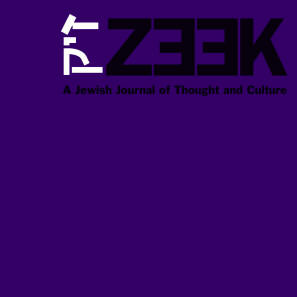 April 07
April 07
Shoot Your Tired, Your Poor, Your Huddled Masses: The Biblical Stories of Adi Nes
Susan Chevlowe
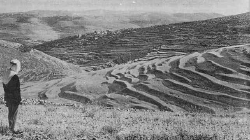 In the 21st century when an artist, particularly one who is Jewish, chooses to engage the Bible through his art, it is natural to see the result as a form of midrash – the tradition of biblical exegesis that imparts a deeper meaning to biblical legend and makes it relevant to contemporary readers. That is what prominent Israeli photographer Adi Nes (b. 1966) has done in his series Biblical Stories (2003-2006), bringing a visual panoply drawn from art history, cinema, and the popular media to bear on familiar biblical texts. Nes’s insights are rendered through acute observations of humanity articulated in the gestures, poses, and expressions of his characters and the settings they inhabit.
In the 21st century when an artist, particularly one who is Jewish, chooses to engage the Bible through his art, it is natural to see the result as a form of midrash – the tradition of biblical exegesis that imparts a deeper meaning to biblical legend and makes it relevant to contemporary readers. That is what prominent Israeli photographer Adi Nes (b. 1966) has done in his series Biblical Stories (2003-2006), bringing a visual panoply drawn from art history, cinema, and the popular media to bear on familiar biblical texts. Nes’s insights are rendered through acute observations of humanity articulated in the gestures, poses, and expressions of his characters and the settings they inhabit.
Nes may be compared to Jeff Wall, the Canadian photographer who popularized contemporary staged photography beginning in the late 1970s. Nes's photographs are intensely physical, with a three-dimensionality enhanced by chiaroscuro lighting, narrative drama, and intense realistic characterization indebted to Caravaggio. Like Wall, he uses actors, although they are not professionals, but ordinary people, and he emphasizes narratives that are open ended, not deterministic, to tell stories about real people and everyday experience. Also, like Wall, he creates cinematographic images that refer to art history, but unlike him he does not rely on digital manipulation or composite images. Perhaps this more traditional approach accounts in part for the great humanism emanating from Nes’s work.
The fourteen images in the series on view at the Tel Aviv Museum through May 23 represent biblical heroes as today's homeless and dispossessed, focusing on their human qualities, their sufferings and hardships. As in his earlier Boys series (2000), the background for Biblical Stories is the social and political reality of contemporary Israel, as it moves further and further away from the socialist ideology of its founders. A photograph from the Boys series, referring to Itzhak Danziger's 1938-39 sandstone sculpture Nimrod, already evinced Nes's awareness of the extent to which biblical narratives have been harnessed to the historiography of the contemporary State of Israel, validating constructions of national identity. His work turned a spotlight on the ambivalent legacy of Nimrod, a biblical hero who was recognized as a mighty hunter as well as a tyrannical ruler – and yet was taken up as an emblem by the cultural-political movement known as “The Canaanites,” which attempted in the 1940s and 50s to shape an Israeli national identity based on ancient Semitic culture. Nes's engagement with the image of Nimrod was related to constructions of masculinity, particularly masculine Israeli identity, as part of what the artists has described as his questioning of "the dream and what happened to it." The Biblical Stories series continues this interrogation, particularly as it looks at the promise Israel has held for immigrants from different backgrounds.
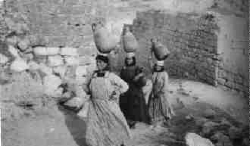 Undermining the purity and promise embodied in the idea of the biblical landscape, Nes chooses the contemporary urban environs of Tel Aviv as the setting for the series. Here one finds a landscape blighted by urban decay in which his figures are alienated from the very land that has given meaning to modern Israeli national identity. Such alienation is a profound symptom of disillusionment: to be homeless in the Jewish homeland is the ultimate irony.
Undermining the purity and promise embodied in the idea of the biblical landscape, Nes chooses the contemporary urban environs of Tel Aviv as the setting for the series. Here one finds a landscape blighted by urban decay in which his figures are alienated from the very land that has given meaning to modern Israeli national identity. Such alienation is a profound symptom of disillusionment: to be homeless in the Jewish homeland is the ultimate irony.
In conceptualizing the Biblical Stories series, Nes draws inspiration from early photographic views of Palestine that pictured contemporary inhabitants as if they had emerged directly out of the biblical text. The demand from tourists, pilgrims, and other Christians for images of the sites that Jesus walked made photography of the Holy Land a profitable enterprise in the 19th century. The rational and scientific nature of the new medium made photography the perfect tool to establish the “truth” of the events of the Bible and legitimize actions based on such affirmations. (Protestants, in particular, with their millennial fervor, sought to convert Jews and Muslims as a precondition of the Second Coming of Christ). The actual lives of the people who lived on the land at the time were obscured by colonizing interests, as is evident in many early survey photographs from which such figures are absent altogether. Other images that did include local people at biblical sites and ruins – most often Arabs and Bedouins – tended to present them in a “timeless” way. As Vivienne Silver-Brody has suggested in Documentors of the Dream: Pioneer Jewish Photographers in the Land of Israel (Jerusalem: Magnes Press, 1998), the land was imaged as “a symbol of faith” framed by Christian theology.
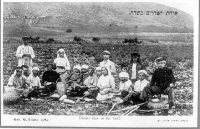 Early Zionists also framed their photographs through a biblical lens, but with other motivations: they envisioned continuity with the Jewish past of Eretz Israel. Artist E.M. Lilien, often called the "first Zionist artist," created biblical illustrations at the fin-de-siècle based on photographic images of costumed local inhabitants for a European market. In affirmation of “the aims of national Zionism” in 1919 (and as noted by Silver-Brody in her study) Ya'acov Ben-Dov photographed a student from the Bezalel Art Academy as Ruth in Bedouin-style clothing, gleaning the fields and holding a sheaf of wheat. Rather than performing the back-breaking work of collecting the leftovers from the harvest, his Ruth was portrayed in a Pictorialist mode within the conventions of ideal 19th-century bourgeois womanhood. To paraphrase Silver-Brody, photography played a central role in grafting a new culture onto an old one. It is significant then that photography, as Nes's work attests, has also played a central role in deconstructing the myths of national identity that the medium had helped to establish.
Early Zionists also framed their photographs through a biblical lens, but with other motivations: they envisioned continuity with the Jewish past of Eretz Israel. Artist E.M. Lilien, often called the "first Zionist artist," created biblical illustrations at the fin-de-siècle based on photographic images of costumed local inhabitants for a European market. In affirmation of “the aims of national Zionism” in 1919 (and as noted by Silver-Brody in her study) Ya'acov Ben-Dov photographed a student from the Bezalel Art Academy as Ruth in Bedouin-style clothing, gleaning the fields and holding a sheaf of wheat. Rather than performing the back-breaking work of collecting the leftovers from the harvest, his Ruth was portrayed in a Pictorialist mode within the conventions of ideal 19th-century bourgeois womanhood. To paraphrase Silver-Brody, photography played a central role in grafting a new culture onto an old one. It is significant then that photography, as Nes's work attests, has also played a central role in deconstructing the myths of national identity that the medium had helped to establish.
In a very real sense, all of Nes's work is about the identities within himself – his Iranian ancestry, his origins in the southern development town of Kiryat Gat, his gay identity, his identity as an artist, as a Jew, and as an Israeli. In this series, he has displaced biblical heroes with contemporary immigrants – the poor, the homeless, and those on the margins of society. They, in turn, have displaced the heroes of earlier Israeli photography of the pioneer generations – the dramatic photographs of nation building and cultivation of the land; in a phrase, images documenting the dream. Undermining these official narratives of Israeli society, Nes's images advance the cause of creating a new story.
 David and Jonathan (2004)
David and Jonathan (2004)
The renewed importance of biblical mythology in Israeli culture in the wake of the 1967 War was instrumental in nurturing Nes’s identity and in shaping his work. (He refers to that war in one of the photographs from his Soldiers series [1994-2000] by quoting the famous Life magazine cover of June 23, 1967, featuring the disarmingly handsome Yossi Ben Hanan with a captured AK-47 cooling off in the Suez Canal). Israel's triumph over its enemies has often been read through the victory of David over Goliath, understood in accord with the Zionist adaptation of biblical narratives to validate contemporary national and political ones. Yet in this photograph, rather than the heroism of David in his defeat of Goliath, Nes chooses to represent David with Jonathan – the beautiful youths whose relationship has figured in art and literature as a homoerotic trope. In Nes's oeuvre, homoeroticism plays a role as a mechanism that exposes the ambivalence in a national narrative grounded in a mythos of heroic masculinity. The moment that Nes represents does not have an exact parallel in the Bible, but it suggests both their parting at which they “kissed one another, and they wept with one another, until David [wept] greatly” (1 Sam. 20:41) and their rendezvous in the Wilderness at Ziph (1 Sam. 23:16-18), when they made a covenant with God and it was understood that Jonathan had put aside his ambitions for David's sake. The young man playing the red-haired David looks directly yet cautiously into the camera, while sheltering the younger boy, Jonathan, who leans into him for support. The pose alludes to the way in which David held his harp, so that he appears to be plucking or playing Jonathan, releasing a silent yet soothing music.
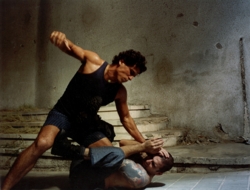 Cain and Abel (2003)
Cain and Abel (2003)
In Cain and Abel (2003) Nes presents another story of homelessness as well as fratricide. Cain murdered his brother out of jealousy that God accepted Abel’s offering but not his own (Gen. 4: 3-8). An altar for the offering may be suggested by the stepped stone platform in the photograph. It is Cain who uttered the famous question “Am I my brother's keeper?” when God asked what had happened to Abel. “What have you done?!” God responded. “The voice of your brother’s blood cries out to Me from the ground” (Gen. 4: 9-10), a moment to which the artist alludes with water dripping down the wall. Abel was punished as God declared that the earth that had absorbed Abel’s blood would be barren and Cain was forced to wander in search of fertile land. And as punishment for his sin, Cain became a “vagrant and a wanderer on earth,” banished to the land of Nod where exiles wander (Gen. 4:14). Nes has addressed the story in two photographs in the series. In the image seen here he casts the Israeli “free fighting champion” and his nemesis in the roles of Cain and Abe l. Although one brother clearly has the advantage over the other, can we really be sure which one is Cain and which Abel? Cain must be the brother with the upper hand, the one with the primitive, animal-like appearance. Yet despite the fact that in the Bible Cain is marked by God for striking down his brother – in evident contradiction of the story – in the photograph Abel is the brother who is heavily tattooed. This ambiguity is in part a measure of the personalities of the “actors,” both titans, neither of whom wanted to be cast as the loser. Thus the photograph reflects the complexity of each brother’s character as well as an alternate reading. Nes seeks to express the idea that “the victim and the perpetrator of violence represent such misery which they have bequeathed to the present human condition.” Perhaps the photograph represents an earlier moment when Abel had the upper hand over his brother, alluding to some biblical commentators’ gloss that Abel was actually the stronger of the two brothers and that Cain tricked Abel into releasing his grasp on him so that he could overcome him.
 Hagar (2005)
Hagar (2005)
Judaism is founded on the paradox of exile. In Genesis 12:1 Abraham, the first Patriarch, is commanded by God: “Go for yourself from your land, from your relatives and from your father's house to the land that I will show you. And I will make of you a great nation.” Abraham obeys and leaves with his wife, Sarah, for Canaan – Eretz Israel. There God appears to Abraham and tells him: “To your offspring will I give this land” (Gen. 12:7). Yet later, Abraham is also told that his offspring “shall be aliens in a land that is not their own.” Nes engages the story of Abraham and his family in two photographs, Abraham and Isaac and Hagar. In Hagar, the protagonist appears as a beggar in a deteriorating, leaf-strewn stairwell open to the elements. The story of Hagar and Ishmael's expulsion by Abraham and Sarah is often used as a symbol of the expulsion of Palestinians during the 1948 War and her name has been appropriated by Israeli peace activists. Nes’s depiction of Hagar can also be interpreted in light of narratives of feminine identity in Israeli culture and their imbrication in politics. Read against projections of Oriental and European notions of femininity vis a vis constructions of Israeli female identity, she is neither the passive, exotic beauty nor the hardworking pioneer who nourishes the land. Yet circumscribed by her role as mother, she is representative of the universalized suffering of a woman who has lost or may lose a child. An icon of anguished Arab or Jewish motherhood, lost in the desert, Hagar is a woman cut off from the land that defines her through the functions of giving birth to and nourishing the boys who will grow into the men who will inherit and control that land or die for it.
